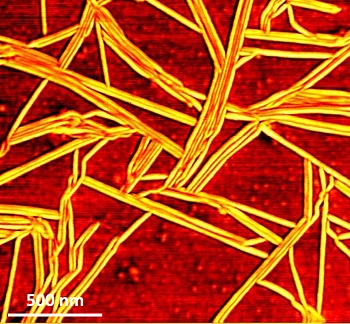Complete aggregation pathway of amyloid β (1-40) and (1-42) resolved on an atomically clean interface
Nirmalraj P, List J, Battacharya S, Howe G, Xu L, Thompson D and Mayer M
Science Advances 08 Apr 2020, Vol. 6, no. 15
Abstract
 To visualize amyloid β (Aβ) aggregates requires an uncontaminated and artifact-free interface. This paper demonstrates the interface between graphene and pure water (verified to be atomically clean using tunneling microscopy) as an ideal platform for resolving size, shape, and morphology (measured by atomic force microscopy) of Aβ-40 and Aβ-42 peptide assemblies from 0.5 to 150 hours at a 5-hour time interval with single-particle resolution. After confirming faster aggregation of Aβ-42 in comparison to Aβ-40, a stable set of oligomers with a diameter distribution of ~7 to 9 nm was prevalently observed uniquely for Aβ-42 even after fibril appearance. The interaction energies between a distinct class of amyloid aggregates (dodecamers) and graphene was then quantified using molecular dynamics simulations. Last, differences in Aβ-40 and Aβ-42 networks were resolved, wherein only Aβ-42 fibrils were aligned through lateral interactions over micrometer-scale lengths, a property that could be exploited in the design of biofunctional materials.
To visualize amyloid β (Aβ) aggregates requires an uncontaminated and artifact-free interface. This paper demonstrates the interface between graphene and pure water (verified to be atomically clean using tunneling microscopy) as an ideal platform for resolving size, shape, and morphology (measured by atomic force microscopy) of Aβ-40 and Aβ-42 peptide assemblies from 0.5 to 150 hours at a 5-hour time interval with single-particle resolution. After confirming faster aggregation of Aβ-42 in comparison to Aβ-40, a stable set of oligomers with a diameter distribution of ~7 to 9 nm was prevalently observed uniquely for Aβ-42 even after fibril appearance. The interaction energies between a distinct class of amyloid aggregates (dodecamers) and graphene was then quantified using molecular dynamics simulations. Last, differences in Aβ-40 and Aβ-42 networks were resolved, wherein only Aβ-42 fibrils were aligned through lateral interactions over micrometer-scale lengths, a property that could be exploited in the design of biofunctional materials. 